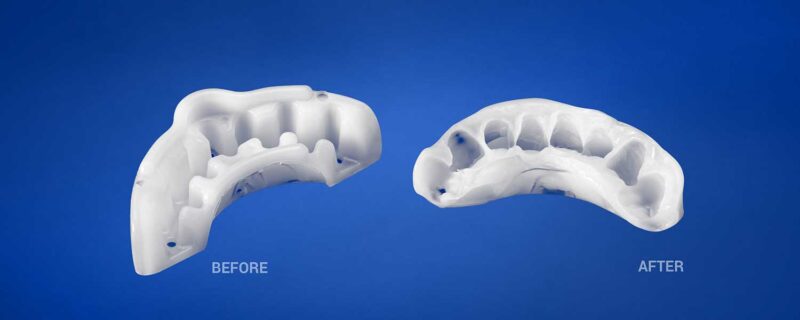The incidence of stress-related bruxism (separate from TMJ pathology) is on the rise nation-wide. According to the ADA, 95% of people will experience bruxism at some time in their life.
The first step in the dental practice is to organize to routinely screen for “silent sufferers”. The prophylaxis cleaning / exam is a first, best-practices opportunity for the dentist and/or hygienist to look for the 13 most common clinically diagnostic clues:
- Wearing and flattening of the teeth
- Tooth fracture
- Gumline notching/abfraction
- Alveolar bone loss
- Root canal treatment with no caries
- Resorption
- Generalized tooth sensitivity
- Toothache when no other dental cause is evident
- Extremely tight cheek muscles
- Jaw pain
- Crepitus or cracking during opening
- Head, shoulder or neck pain
- Difficulty opening or staying open
If several of these are present, or NOT, routinely ask each patient if they have been experiencing “jaw pain” particularly upon waking, or are they aware of clenching/grinding.
GrindRelief PRO packaging provides reception/treatment room pamphlets and wall placards to help “raise the question” and identify these patients. Early diagnosis and immediate treatment at a reasonable fee benefit the patient and your practice.
Very often patients with Obstructive Sleep Apnea (OSA) also suffer from nighttime bruxism; regular patient health histories may reveal these patients to you.
GrindRelief PRO does not require models, laboratory fees, nor multiple appointments. You can offer economical therapy the same day you diagnose. Invented and patented by a dentist who suffered from bruxism, the appliance features a unique Central Power Bar, to prevent bite-through and reduce harmful muscle activity by 60% or more. The Power Bar creates pressure on the upper and lower mid-lines simultaneously.
The GrindRelief can be fitted by the dentist, the chairside assistant or a hygienist in about 10 minutes. All that is needed is a bowl of hot water (~1600F), about the temperature of a cup of freshly brewed coffee.
The video shows exactly how to warm it, mold it and confirm and assure proper fit. This is a practical and economic benefit for you and the patient.
When it is correctly fitted, it will be comfortable (not crimping or torqueing the teeth) but should require removal from the mouth with the fingers. The patient should not be able to dislodge it with the tongue nor cheeks during sleep.
Also, here is a link to the Instructions For Use card that also comes in the GrindRelief PRO prepack.
In some cases, you may want to provide a protective clear splint for the opposing arch. The GrindRelief PRO also includes clear 0.20’’ sheets (potentially one for each of the GrindRelief devices) for your vacuum-forming machine.
Because the GrindRelief can be softened and re-fitted as often as needed, it is also perfect for children, whose dentition will change, or re-fit when subsequent restorative/prosthetics are provided. By contrast, the original, lab-made NTI and hard acrylic horseshoe splints must be re-done completely in these situations.

GrindRelief PRO can be fitted to upper or lower arches, by the dentist or auxiliary, in 5-6 minutes and it can be re-fitted if needed. Extending only to the first premolars, it is more comfortable than horseshoe splints, for better compliance. GrindRelief PRO is offered at quantity discounts, with instructive videos, marketing collaterals, patient storage cases and more.
Lower cost, less time, highly efficient, more profitable.
Easy to Use:
The GrindRelief should NOT BE PLACED in patients with missing anterior teeth nor with diastemas or other natural undercuts, as easy insertion and removal may be challenged. Orthodontic wires preclude use of the GrindRelief.
The GrindRelief is designed to be effective but comfortable. Sometimes, after the patient is released and in treatment, the plastic may slightly shrink and the device tighten slightly. One of the great benefits of GrindRelief is that it can be re-softened and recalibrated if needed. This could be a drop-by office visit, or the patient can be instructed by phone or video call.
In very rare cases, if the patient cannot remove the GrindRelief, this video demonstrated the in-office technique to mechanically remove it.
